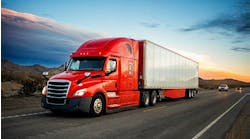Under the authority of Section 232 of the Trade Expansion Act of 1962, President Donald Trump is moving forward with 25% tariffs on imported cars, light trucks, and vans, as well as parts including engines, transmissions, powertrain parts, and electrical components—with more possible down the line, according to the administration. As per MEMA’s interpretation, medium- and heavy-duty vehicles will not be included.
The tariffs for the vehicles will kick in April 3, and parts no later than May 3.
There are some other caveats. For vehicles coming from Mexico and Canada, the tariffs will apply only to the percentage made outside of the U.S. For example, a pickup assembled in Mexico but using an American-made engine would have a lower duty tax applied than one with a Mexican-made engine.
The administration also noted that “[United States-Mexico-Canada Agreement]-compliant automobile parts will remain tariff-free until the Secretary of Commerce, in consultation with U.S. Customs and Border Protection (CBP), establishes a process to apply tariffs to their non-U.S. content.”
The actions are meant to restore what the president deems an unfair trade balance.
“This is the beginning of liberation day in America,” Trump said from the Oval Office. “We’re going to charge countries for doing business in our country for taking our jobs and taking our wealth.”
The latest White House fact sheet detailing the auto tariffs reported that over the last 40 years, American consumers went from buying 97% U.S.-made vehicles to 50%. And of the 8 million vehicles still produced domestically, 40 to 50% of their content was made in America. The total trade deficit for auto parts reached $93.5 billion last year, while the auto parts sector lost 34% of its workforce (286,000) since 2000, the report stated.
Impact on trucking
Despite these tariffs not directly imposed on medium- and heavy-duty trucks, the industry is expecting an economic downturn due to Trump’s plan for overall reciprocal tariffs that start on April 2. The thinking is that tariffs would raise prices on goods, thus decreasing the amount sold, hurting the freight market.
A mid-March survey from FleetOwner (sample size: 300) indicated 39% had a very negative view of Trump’s actions in relation to trucking, versus 25% very positive.
One owner operator who took the survey said: “Since his term started, there is no rhyme or reason for the tariffs or other decisions that are currently driving down demand for our services. Imports to and from Canada and Mexico are dwindling down, so there's basically 75% of my business down the tubes.”
The president’s America-first agenda still resonates with others. A truck dealership employee responded: “He [Trump] has the long-term best interest of the country in mind. The tariffs are going to make things shaky for a bit, but we will come out better.”
Earlier this week, Hyundai announced a plan to invest $21 billion in the U.S., with nearly $6 billion of it going to a Hyundai Steel plant in Louisiana.
"This investment is a clear demonstration that tariffs very strongly work," Trump said following the announcement.




